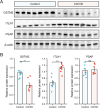Seminal plasma proteomics of asymptomatic COVID-19 patients reveals disruption of male reproductive function
- PMID: 40119256
- PMCID: PMC11927139
- DOI: 10.1186/s12864-025-11473-5
Seminal plasma proteomics of asymptomatic COVID-19 patients reveals disruption of male reproductive function
Abstract
Background: A considerable proportion of males suffer from asymptomatic SARS-CoV-2 infection, while the effect on reproductive function and underlying pathomechanisms remain unclear.
Results: The total sperm count decreased evidently after asymptomatic infection, yet all semen samples were tested to be SARS-CoV-2 RNA negative. Through label‑free quantitative proteomic profiling, a total of 733 proteins were further identified in seminal plasma from 11 COVID-19 patients and seven uninfected controls. Of the 37 differentially expressed proteins, 23 were upregulated and 14 were downregulated in the COVID-19 group compared with control. Functional annotations in Gene Ontology (GO), Kyoto Encyclopedia of Genes and Genomes (KEGG), and Reactome showed that these proteins were highly enriched in infection, inflammation, and immunity-related pathways as well as spermatogenesis-associated biological process. Four proteins were significantly correlated with one or more semen parameters in Spearman's coefficient analysis, and seven were filtered as potential hub proteins from the interaction network by MCODE and Cytohubba algorithms. Furthermore, we verified the proteomic results by Western blot analysis of three representative proteins (ITLN1, GSTM2, and PSAP) in the validation cohort.
Conclusions: In summary, our study showed that acute asymptomatic COVID-19 could alter the seminal plasma protein profile without direct testicular infection and consequently lead to impaired semen quality. These novel findings should enlighten the physicians about the adverse effects of SARS-CoV-2 infection on male fertility, and provide valuable resources for reproductive biologists to further decipher the molecular functions.
Keywords: COVID-19; Proteomics; SARS-CoV-2; Seminal plasma.
© 2025. The Author(s).
Conflict of interest statement
Declarations. Ethics approval and consent to participate: The study was approved by the Reproductive Medicine Ethics Committee of Jiangxi Maternal and Child Health Hospital, and conducted in accordance with the Declaration of Helsinki. All patients signed informed contents before participation. Consent for publication: Not applicable. Competing interests: The authors declare no competing interests.
Figures





Similar articles
-
Proteomic analysis reveals the negative modulator of sperm function glycodelin as over-represented in semen exosomes isolated from asthenozoospermic patients.Hum Reprod. 2019 Aug 1;34(8):1416-1427. doi: 10.1093/humrep/dez114. Hum Reprod. 2019. PMID: 31355853
-
Functional proteomic analysis of seminal plasma proteins in men with various semen parameters.Reprod Biol Endocrinol. 2013 May 11;11:38. doi: 10.1186/1477-7827-11-38. Reprod Biol Endocrinol. 2013. PMID: 23663294 Free PMC article.
-
COVID-19 and male reproductive function: a prospective, longitudinal cohort study.Reproduction. 2021 Mar;161(3):319-331. doi: 10.1530/REP-20-0382. Reproduction. 2021. PMID: 33522983
-
SARS-CoV-2 Vaccine Effects on Semen Parameters: A Systematic Review and Meta-Analysis.Arch Esp Urol. 2022 Dec;75(10):831-843. doi: 10.56434/j.arch.esp.urol.20227510.121. Arch Esp Urol. 2022. PMID: 36651093
-
Effect of COVID-19 on Male Reproductive System - A Systematic Review.Front Endocrinol (Lausanne). 2021 May 27;12:677701. doi: 10.3389/fendo.2021.677701. eCollection 2021. Front Endocrinol (Lausanne). 2021. PMID: 34122351 Free PMC article.
References
-
- Wise J. Covid-19: WHO declares end of global health emergency. BMJ. 2023;381:1041. - PubMed
-
- World Health Organization. WHO coronavirus disease (COVID-19) dashboard. Available from: https://covid19.who.int/. Accessed February 15, 2024.
MeSH terms
Substances
Grants and funding
LinkOut - more resources
Full Text Sources
Medical
Research Materials
Miscellaneous

